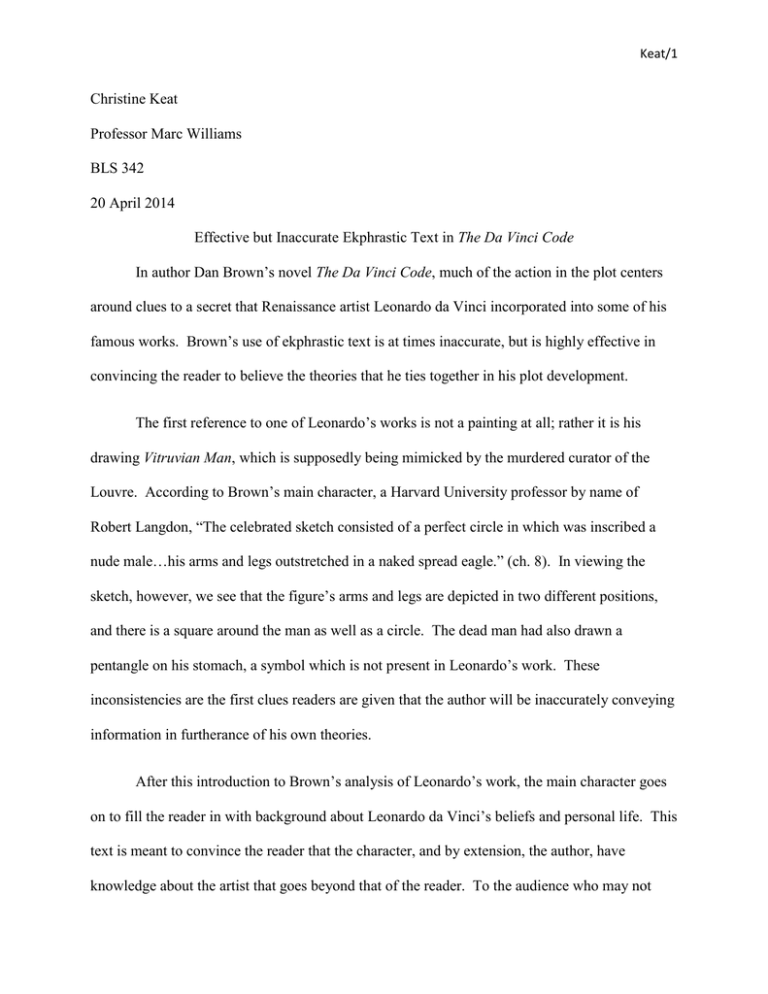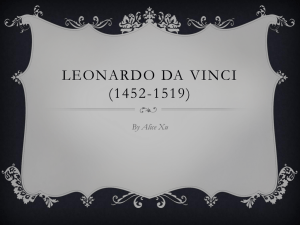Da Vinci Code
advertisement

Keat/1 Christine Keat Professor Marc Williams BLS 342 20 April 2014 Effective but Inaccurate Ekphrastic Text in The Da Vinci Code In author Dan Brown’s novel The Da Vinci Code, much of the action in the plot centers around clues to a secret that Renaissance artist Leonardo da Vinci incorporated into some of his famous works. Brown’s use of ekphrastic text is at times inaccurate, but is highly effective in convincing the reader to believe the theories that he ties together in his plot development. The first reference to one of Leonardo’s works is not a painting at all; rather it is his drawing Vitruvian Man, which is supposedly being mimicked by the murdered curator of the Louvre. According to Brown’s main character, a Harvard University professor by name of Robert Langdon, “The celebrated sketch consisted of a perfect circle in which was inscribed a nude male…his arms and legs outstretched in a naked spread eagle.” (ch. 8). In viewing the sketch, however, we see that the figure’s arms and legs are depicted in two different positions, and there is a square around the man as well as a circle. The dead man had also drawn a pentangle on his stomach, a symbol which is not present in Leonardo’s work. These inconsistencies are the first clues readers are given that the author will be inaccurately conveying information in furtherance of his own theories. After this introduction to Brown’s analysis of Leonardo’s work, the main character goes on to fill the reader in with background about Leonardo da Vinci’s beliefs and personal life. This text is meant to convince the reader that the character, and by extension, the author, have knowledge about the artist that goes beyond that of the reader. To the audience who may not Keat/2 have studied art or the Renaissance, his words sound true and knowledgeable, but is it an established fact that Leonardo was a prankster who liked hiding pagan symbols in art commissioned by the Catholic Church? Or that he liked to paint himself as a woman? The next one of Leonardo’s works that Brown introduces readers to is the Mona Lisa. He accurately names the style of painting sfumato, but then goes on to describe the uneven background and uneven facial symmetry as signs of the artist making the female half of the subject more majestic. In examination of the painting, the landscape in the background appears uneven because it is a representation of nature. There is a lake, a mountain, and some land. These natural features are never even. The mountain is on the right side of the painting, therefore draws the eye to the left side of the subject’s face. Additionally, the subject is not facing directly ahead. She is turned slightly to her left. In painting a three-dimensional object and attempting to recreate depth, what is nearer must be larger than what is further away from the viewer. While Brown, through his main character, suggests that this unevenness has a hidden meaning, it is in no way conclusive. The other suggestion that he presents, that the Mona Lisa is a portrait of Leonard himself in women’s clothing, he offers as just that – a suggestion, not fact. However, he goes on to state “his Mona Lisa is neither male nor female” (ch 26), which conflicts with his earlier statements about the painting being a tribute of some sort to feminine divinity. In describing the painting Madonna of the Rocks, Brown accurately represents the figures who are present, but his identification of them is not unquestionable. There are two young children, and they are identified based on who is closest to Mary, ignoring that it is entirely plausible that she is introducing young John the Baptist to her son, who is offering a blessing from his place near Uriel. Brown again uses the presumed authority of his main character, Professor Robert Langdon to infuse meaning behind the positions and gestures of those figures Keat/3 that serve his theories. Viewers see the Madonna’s hand held over a child, one child pointing and another with hands clasped, and an angel pointing. There is no talon grasping an invisible head. There is no angel slicing the neck of an invisible head. It is only after the viewer of the painting reads what Langdon has to say that Mary’s hand becomes threatening rather than protective, and the pointing hand of one child becomes a blessing. For The Last Supper, Brown establishes his knowledge by having the character Leslie Teabing, a royal historian and Grail expert, announce that there is not a chalice on the table; rather everyone has their own glass to drink from. Readers who have not previously studied the painting in detail quickly realize he is right, and therefore are more likely to believe the rest of what Teabing and Langdon have to say about the painting’s meaning. The figure seated to Christ’s right does indeed have flowing hair. So do several other figures, including Christ himself. Viewers of the painting do not see any suggestion of a bosom on this figure; if they do, there are others at the table whom the same can be said of. The two figures do not appear to be joined at the hip, as Teabing suggests, nor does Christ appear to be leaning away. By incorporating just enough fact into his ekphratic text, Dan Brown gives readers an impression of knowledgeable authority and thus convinces them that his theories are plausible. Often a well-told story will convince an audience that they saw something that they did not actually see. In the case of The Da Vinci Code, the author has used his inaccurate ekphrasis very effectively, and the result has been a renewed interest in the works of the artist Leonardo da Vinci. Keat/4 Works Cited Brown, Dan. The Da Vinci Code. New York: Doubleday, 2003. Kindle file.






